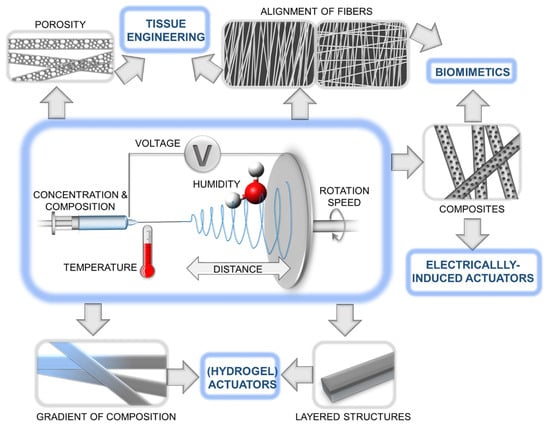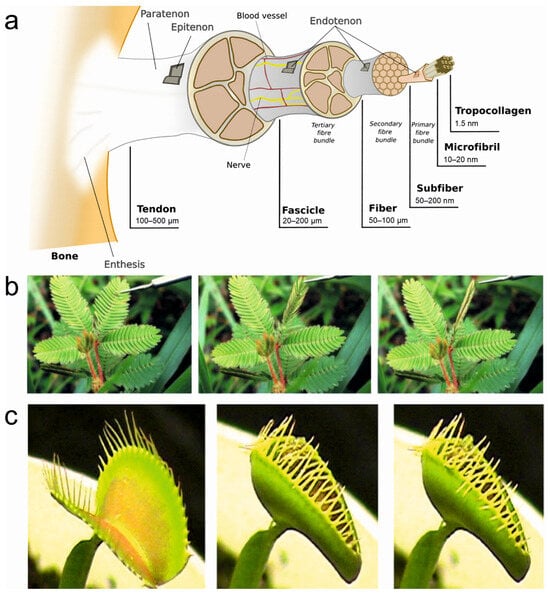A number of biological systems exhibit a shape change process when exposed to a wide variety of environmental changes, thus enabling sensing and responsive functionalities
. Synthetic materials can be programmed to intrinsically respond to environmental changes in a similar manner and have the potential to revolutionize materials science. One such example is shape-memory polymers, which can recover their original shape after being exposed to an external stimulus, such as heat, light, or a magnetic field
. These materials are unique as they can undergo a transition between a temporary shape and a permanent shape. The polymer is first programmed into a high-energy temporary shape by using a specific programming procedure. By exposure to an external stimulus, it reverts to its low-energy permanent shape. These polymers have attracted significant attention in recent years due to their potential use in a wide range of applications, including biomedical devices, aerospace, automotive, and textiles
. Recent studies have focused on the development of shape-memory electrospun fibrous meshes with actuation capabilities. These fibrous meshes have shown interesting advantages over bulk materials such as a faster recovery process, due to their high surface area (in the case of a thermally triggered process) and faster diffusion (in the case of a water-triggered process)
. They have also shown relatively high values of shape fixity and shape recovery ratios, with values ranging between 80% and somewhat higher than 90%. These benefits enable a versatile and customizable platform for developing advanced materials with enhanced mechanical, sensing, and actuation properties for various applications, including biomedical devices, smart textiles, and aerospace components
. However, most of these electrospun fibrous meshes are limited to a single, irreversible change in shape or pore size and the application of an external stress is required to program the sample
. Only few reports have dealt with reversible actuations or programmable pore size changes under stress-free conditions in covalently or physically crosslinked electrospun fibrous meshes.
Electrospun SMPs based on covalently crosslinked poly(ε-caprolactone) (cPCL) fibrous meshes enabled a bidirectional reversible actuation and a temperature-controlled reversible change in porosity
[63]. A two-step preparation procedure was used to achieved the cPCL fibrous meshes. In the first step, the electrospinning of a blend of PCL with triallyl isocyanurate (TAI) and benzophenone (BP) was carried out, while in the second step, the electrospun fiber meshes underwent a photoinitiated crosslinking process. To observe the actuation behaviour, the meshes underwent deformation at an elevated temperature and cooling while keeping the deformation strain.
4.2. Physically Crosslinked Electrospun SMP Actuators
To avoid the secondary crosslinking step by exposure to UV light, in situ crosslinking of electrospun fibers based on stereocomplexation was studied. Blending of a multiblock copolymer containing poly(L-lactide) and poly(
ε-caprolactone) segments (PLLA-PCL) with oligo(D-lactide) (ODLA) in a one-step solution-casting process resulted in the formation of a stereocomplex
[64]. This physical networking between the opposite enantiomers of PLA organized them into a periodic crystalline structure. The actuation behavior of the electrospun meshes and the bulk material was tested. The electrospinning process resulted in a higher molecular orientation, enabling an improved shape-memory actuation performance in the microfiber meshes compared to the bulk material. The actuation magnitude of
εrev = 5.5 ± 0.5% in bulk PLLA-PCL/ODLA blends was increased to 7.8 ± 0.8% in fibrous meshes. Twisting the electrospun fibers into a yarn resulted in a further increase of actuation to 15 ± 1.8%. This was attributed to the improvement in the structural integrity of the fibers. The simultaneous orientation of polymer molecules and their crosslinking into a physical network opens a broad perspective for the development of actuating fiber meshes.
5. Electrospun Electroactive Actuators
Actuators based on electroactive polymers (EAPs) can operate when stimulated by an electric field. Due to the high surface-to-volume ratio of nanofibers and the porous structure of nanofibrous meshes, electrospun nanofibers have led to the fabrication of high-performance and versatile actuators [65][66][67]. One of the most promising applications of such devices is artificial muscles, which can mimic the function of natural skeletal muscles, and therefore, have potential applications in biomimetic robots and biomedical devices [5][7]. In recent years, various nanomaterials have been utilized to obtain artificial muscles and improve their mechanical, electrical, and electrochemical properties [68][69].
Actuation of such devices can happen according to two mechanisms based on electromechanical and electrochemical reactions. Electromechanical (electric) actuation is related to electric dipole rearrangements in electroactive polymers that cause dimensional changes, while electrochemical mechanisms utilize electrostatic forces, in which the ion exchange mechanism is responsible for volume changes in ionic electroactive EAPs [70][71]. In comparison to electromechanical, ionic EAPs offer a significantly lower voltage (1–2 mV); therefore, they can find applications in the medical field, especially in the preparation of artificial muscles.
Much attention has been paid to the fabrication of conductive polymer-based actuators having nanofibrous structures [72][73]. However, direct fabrication of conducting polymer nanofibers using the electrospinning process is challenging due to the fact that typically, polymers with a low molar mass that are produced show inherent brittleness, as often the corresponding monomers have poor solubility in common solvents [74]. Therefore, several alternative approaches have been utilized to incorporate conducting polymers (CPs) into fibrous structures. The most common are the following: co-axial electrospinning to produce core–shell nanofibers and preparation of electrospinnable blends of polymers with CPs, which can be processed by electrospinning [75][76][77]. However, they result in the formation of a nanofibrous layer with low electrical conductivity and poor electrochemical properties for use as an actuator. A direct polymerization of CPs on the surface of substrate nanofibers is a simple and versatile technique for producing CP nanofibers of a core–shell structure [78]. Therein, a conducting polymer layer is on the surface of the fibers, which provides an effective nanofiber-conducting polymer-based actuator [79].
Electroactive Actuators for Manufacturing Artificial Muscles
For the purpose of electrospun electroactive actuators, biopolymers such as cellulose
[80], cellulose acetate (CA)
[81], gelatin
[82], chitosan
[83], and silk
[84] have been considered, particularly in biological and medical applications
[85]. In most cases, biopolymer-based nanofibrous substrate is intended to increase the biocompatibility of an actuator. However, some biopolymers, such as CA, have naturally electrical actuation ability, which due to their synergistic effect with the active component, improve the final actuation performance of bioactuators
[16][86]. Furthermore, due to their doping ability, CPs such as polypyrrole (PPy)
[87][88], poly(3,4-ethylenodioxythiophene) (PEDOT)
[79], and polyaniline (PANI)
[82][89] can be used in conjunction with biopolymers to produce fibrous bioactuators for in vitro or in vivo applications, especially artificial muscles
[90][91]. The chemical structure of CPs can expand and contract due to a flux of ions/solvent in and out of the polymer matrix when the conjugated backbone is electrochemically oxidized and reduced when low voltages are applied (1–2 V) in the presence of an electrolyte
[92].
6. Electrospun Actuators Based on Liquid Crystalline Elastomers (LCEs)
LCEs constitute a class of materials that possess both elastic properties as conventional elastomers and anisotropic physical properties due to their liquid crystalline state of order. LCE-based microfiber actuators based on the nematic–isotropic phase transition of liquid crystal mesogens were reported to generate a large actuation strain of 60% with a simultaneous fast response <0.2 s and a high power density of 400 W/kg. Furthermore, when coated with a polydopamine layer, the actuation of the electrospun LCE microfiber could be precisely and remotely controlled by a near-IR laser through the photothermal effect. Krause et al. obtained electrospun crosslinked nematic fibers with a uniform alignment
[19]. These highly oriented fibers exhibited a liquid crystalline state under ambient conditions.
7. Summary
Electrospinning has emerged as a modern and versatile fabrication technique, offering unique advantages for the production of advanced materials with diverse applications.
Through the ingenious combination of electrospinning and hydrogel technology, intricate fibrous structures are crafted, resulting in actuators that exhibit remarkable shape-changing abilities in response to external stimuli. The actuation in electrospun hydrogel actuators is inspired by the skin of human hands
[38] and pine cones
[39], which provide reversible movements based on swelling/deswelling effects in a bilayered structure. The active layer of the actuators can uptake water, resulting in volume increase and the passive layer is inert to dimensional change. These bilayer structures based on electrospun hydrogel meshes have enabled bending movements, which rely on internal mechanical stresses generated at the interface of the two layers.
SMP fibrous meshes have shown immense potential and exciting prospects for the cutting-edge technology in the field of soft robotics and beyond
[55]. However, only a few studies related to electrospun SMPs enabling a reversible actuation have been reported. Electrospun actuators based on a crosslinked PCL resulted in an actuation performance of
ε’
rev = 15%, while for PEVA-based actuators, their value of
ε’
rev could vary in a range from 10 ± 1% to 17 ± 2% depending on the alignment of the fibers
[63]. The post curing of PCL and PEVA fibers by exposure to UV light could be avoided by blending a multiblock copolymer based on PLLA and PCL (PLLA-PCL) with oligo(D-lactide) (ODLA). Here, the stereocomplex formation between the opposite enantiomers of PLA enabled physical crosslinks in the blend
[93]. The fibrous meshes of the PLLA-PCL/ODLA blend resulted an actuation magnitude of
εrev = 7.8 ± 0.8%, which could be increased to 15 ± 1.8% by twisting the electrospun fibers into a yarn
[64].
Electrospun actuators harnessed from conductive polymers (CPs) leverage the unique electroactive properties of polymers, responding to electrical stimuli with dynamic shape changes. However, due to poor physical features induced by insolubility, infusibility, and brittleness, the applicability of CPs as actuators requires significant challenges to be addressed. As the utilization of electrospinning requires organic solvents for the preparation of solution, therefore, the synthesis of new CPs by the modification of existing CPs or synthesis of new derivatives with improved solubility and spinnability is mandatory. Furthermore, it is important to further improve the conductivity and thermal stability of electrospun CP fibers. This can be performed by the fabrication of CP-based electrospun composites containing a variety of nanofillers, such as inorganic metal oxides, CNTs, graphene, carbon nanotubes, metal or semiconductor nanoparticles, and quantum dots. It has been shown that preparation of polymer-based composites such as Au-doped poly PAN–PANI core–shell nanofibers
[94], silver-doped PVDF fibers
[95], or PVA/polyurethane/Au
[96] can improve these properties and lead to better applicability due to better conductivity or thermal stability
[97].


